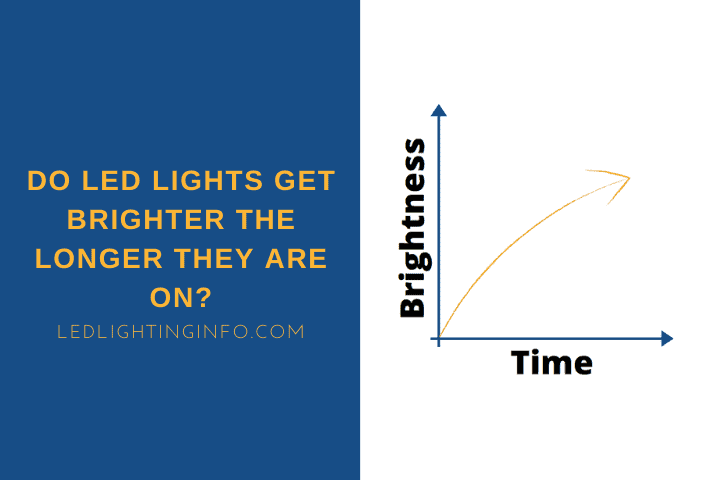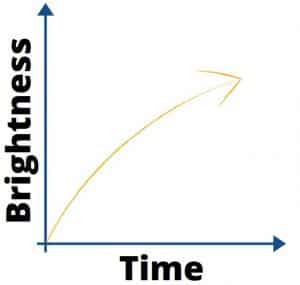In the age of technology, people are accustomed to having on-demand access to whatever they want.
Want to watch a film?
You can go on to Netflix and stream it instantaneously. Run out of laundry detergent? You can go to Amazon and get some delivered within an hour.
Whatever the situation, people in 2020 hate waiting.
The same logic applies to lighting. When somebody needs a light, they want it immediately and will become frustrated if they’re made to wait.
Most smartphones have an instant flashlight feature, so why can’t the bulbs in your dining room?
That’s where LEDs come in.
LEDs are often described as an instant kind of light since they achieve full brightness as soon as they are turned on. This means that LEDs do not gradually get brighter, as most LEDs can reach full brightness in less than 500 milliseconds.
As incandescent bulbs become wholly obsolete, more people are starting to realize the energy-saving potential of LEDs.
If you’re interested in finding out how LEDs work and what prevents them from gradually getting brighter like other bulbs, then keep reading!
Do LED Lights Need Warm Up Time?
To understand why LED bulbs do not need time to warm up, let’s start by analyzing why conventional bulbs do.
CFL, fluorescent, and incandescent bulbs require heat to produce light. Heat is not an instant process, so it takes time for conventional bulbs to go from 0°F to their designated temperature. Until they’ve reached this optimum level, conventional bulbs are incapable of producing light.
Think of this process like boiling a kettle – flicking the switch doesn’t immediately create boiling water. You have to wait for the water to heat up before you can use it in your coffee.
In contrast, LEDs create light using a semiconductor. Semiconductors contain two components; negatively charged electrons and positively charged holes.
When an electric current is supplied, the electrons can pass over and combine with the holes, which releases energy in the form of photons (light). This process is called electroluminescence.
Since no heat is involved, LEDs do not need time to warm up.
Why Do LED Lights Turn Instantly On?
The absence of heat in LED bulbs also explains why they’re able to instantaneously achieve full brightness.
The semiconductor element of a diode has two possible states: either the electrons and holes are separated or the electrons and holes are combined. When they’re separated, no light is produced. But when they’re combined, the LED generates light.
Essentially this means that LEDs can only ever be on or off. The electrons and holes cannot be partially combined, so there is no middle ground. In this sense, light emission is the primary effect of a LED, whereas, in conventional bulbs, it is a secondary effect.
Don’t worry, I know what you’re thinking. “But I’ve seen LEDs that don’t turn instantly on, how do they work?”
Well, some LED bulbs on the market intentionally feature artificial delays and soft starts. These work through flickering and pulse width modulation (PWM).
LED bulbs flicker at a rapid rate that is undetectable to the human eye. By adjusting the length of time between these flickers, light can appear duller. The electrons and holes are still connected, and the LED is operating at full brightness. Nevertheless, these flickers create an illusion of characteristic delay.
Why Did My LED Light Get Brighter?
With that in mind, if you notice that your LEDs are gradually getting brighter, something has probably gone amiss. There are a few possible scenarios.
The most common fault in LEDs is bad connections. LEDs consist of several components – a diode, an LED driver, and a power supply.
Each circuit has lots of different wires and connections, which means your LEDs will get brighter or duller depending on whether the connection is good or bad.
If you’re confident with electronics, open up your fixture and check for loose, obstructed, or frayed wires. If you don’t want to do this yourself, you can take your LEDs to an electrician.
Alternatively, the issue could be related to an incompatible dimmer switch. LEDs typically operate at 12 to 24 volts, which is much lower than both conventional bulbs and mains electricity supply.
This means that universal dimmers are not always compatible with LEDs as they’re designed to dim high-powered circuits. Using a high-powered dimmer may overdrive the LED, causing it to get brighter.
For a more in-depth analysis, have a read of my post on flickering LEDs.
Types Of Light Bulbs That Gradually Get Brighter
You and I both know that time spent waiting feels much longer than it actually is.
So it may be useful to know how long you have to wait for conventional thermal bulbs to reach full brightness.
When CFLs are switched on they will emit a faint glow, but typically take up to three minutes to reach full lumen output.
In CFLs, electricity passes through a tube containing argon and mercury vapor. The current excites the vapor, causing it to emit ultraviolet radiation.
UV is invisible to the human eye, so a phosphor coating is used to convert the rays to visible light.
The bulb, therefore, won’t reach full brightness until all the phosphor has started to glow.
But manufacturers have decreased this start up time over the years by implementing ballasts that supply the bulb with more power during the warm-up phase.
The same is true of HID lamps, of which there are 5 main types: mercury vapor, low-pressure sodium, high-pressure sodium, metal halide, and ceramic metal halide.
These bulbs are most commonly found in industrial settings, such as street lights.
These lamps produce light by sending an electric arc through vaporized gas, such as argon, xenon, or mercury.
Starting the arc takes a few seconds but the full warm-up period usually lasts around 4 minutes.
One thing’s for sure, CFLs and HIDs are not the best lighting solution for emergencies!
Final Words
Hopefully, this post has helped to clarify why LED bulbs are the way forward. As well as being incredibly long-lasting, LEDs are energy efficient and provide instant brightness.
Despite this, in 2016 the US Environmental Protection Agency introduced stricter requirements on the start-up performance of LED luminaires.
The program set out that LEDs must have a start time no higher than 500 milliseconds!
Do you prefer bulbs that start-up instantly or those that feature an aesthetic fade-in?
Write a comment down below and let me know.
Looking for an LED bulb but not sure what type you need?
Check out my free bulb picker and select the right bulb within few clicks.



